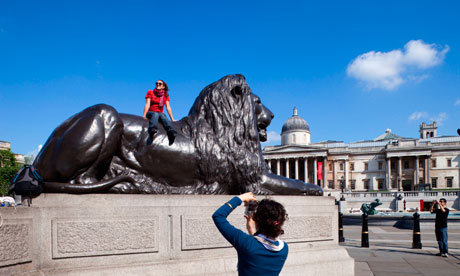
Without a shadow of doubt Trafalgar Square has to be one of the most crap urban public spaces in the world. The fact that massed divisions of tourists feel compelled to ritually promenade across its pigeon-shat-upon York stone and head-banging granite is perverse in the extreme, because it's not so much a place to hang out as somewhere you feel constantly in danger of being hung for treason, such is the discourse of power enshrined in its leonine and general-studded plinths and its admiral-spiked column.
True, the National Gallery makes a pleasing non-event horizon for the square as you enter it from Whitehall or the Mall; a long range of neoclassicism, with its Saracen's helmet dome, it's bare to the point of Moorishness. St Martin-in-the-Fields is also difficult to object to unless you've a perverse inclination against its unexceptionable architecture and illustrious history of beneficence.
However, surrounding the rest of it are tedious Edwardian-club-bore buildings – South Africa House, Canada House and the rest – that underawe with their weighty bombast.
There's this, and there's the perverse cant of the square, which rises south-west to north-east to form a raked stage upon which something ought to happen. What usually happens on it is that organs of the state corral one group of malcontents or other before hitting them with sticks, riding over them on horseback, and on one or two notable occasions – such as the original Bloody Sunday of 1887 – render some of them appropriately stone-dead.
Of course, barring the occasional demonstration, the Square doesn't have much happening in it at all, apart from full-grown Italian men with goatees climbing on to the backs of Landseer's lions, and giant Scandinavian teens rolling up their jeans and wading in the fountains until authority spurts them out.
Yes, yes, I know: mayors of all stripes put on concerts there, and also erect big screens on which events of some sort or other are displayed. I've seen this sort of carry-on when I cross the square – usually bottom-left to top-right – on my way to the opera, Soho and other more interesting destinations.
Trafalgar Square is so compellingly naff that it was the obvious location for that repulsive Olympic countdown clock – as it is annually for that enormous fir tree the Norwegian people insist on sending us – even though we've asked them very politely not to.
Who was it who said, "Corridors have become destinations"? Ah, yes, Rem Koolhaas in his seminal 2002 essay Junkspace – but he could've been talking about Trafalgar Square, at least since the completion of Admiralty Arch in 1912. Prior to that the square was … well, less square for a start. And it also had housing facing directly on to it – some distinctly ducal, such as Northumberland House, but others that were a recognisable part of the old bricky weave of London. It had housing, and even quite modest shops – now all that's left of the commercial activity that once gave the capital its distinctive street life is a Tesco Express, a Waterstone's and, further along towards Pall Mall, the offices of various implausible Central Asian airlines with names like GhengisAir.
Yes, once the Arch was overarching and the Mall came into being (prior to 1912 it was a long row of hedges), Trafalgar Square became a corridor that was a destination, by which I mean it was a site to be visited rather than lived in. Dead and about-to-be-married royals must be dragged through its environs as part of a kissing of the ritual stations of the state's holy cross – winning sports teams ditto.
Almost all attempts to gussy up the Square and make it more user-friendly – think the Fourth Plinth new sculptures, and the pedestrianisation of the northern side – are doomed to failure, precisely because of its bombast and the petrified generals laughing stonily in the face of anything light, frothy or fun.
Of the recent Fourth Plinth sculptures only Marc Quinn's Alison Lapper Pregnant has gone any way towards bending the square's rectilinear rigidity. With its subversion of the conventionally standardised representations of the body the square specialises in, and its bright white marble – the albedo of which attracted a good proportion of the flying rats – Quinn's statue made a stab at the flinty heart of the Brit establishment.
Unfortunately it couldn't possibly penetrate far enough. What's needed are cafes all over the gaff, open-air and serving excellent espresso; top-notch strolling and – unlicensed – buskers; Horatio's nob chopped off halfway down; at least one of the lions upended; an open-air market; some good ethnic food stalls; and possibly a snake charmer or 20 …
Overall, think Marrakech's Djemaa el-Fna and you wouldn't be far wrong. Oh, and did I mention the weather?
Will Self's novel Umbrella will be published by Bloomsbury in August

